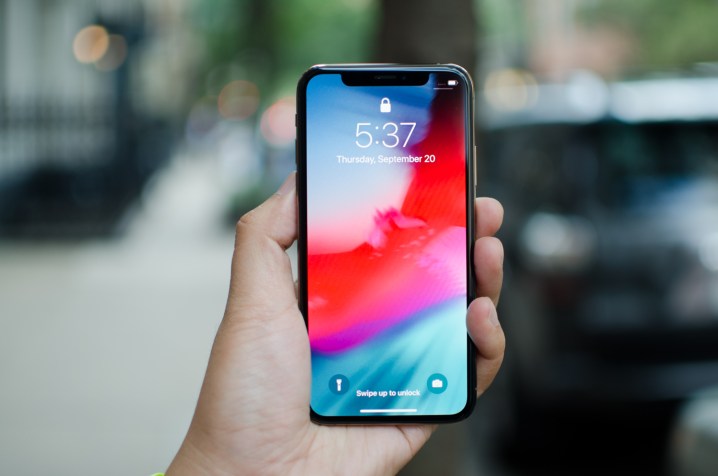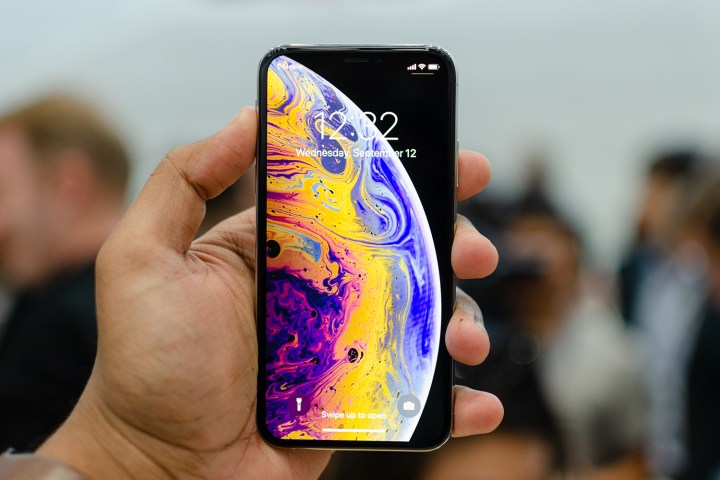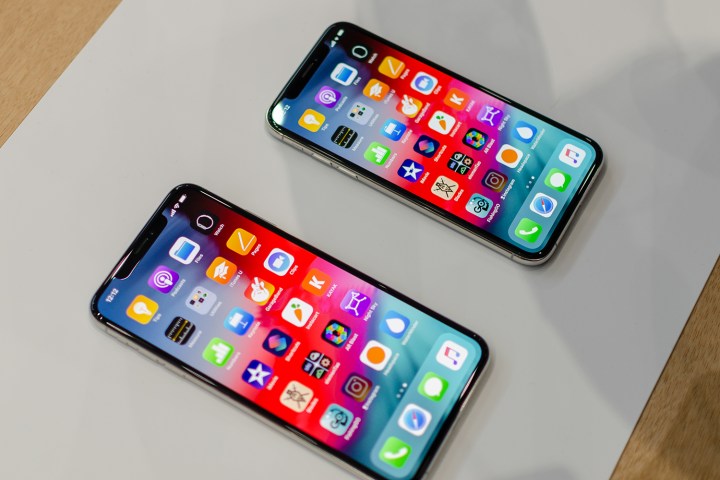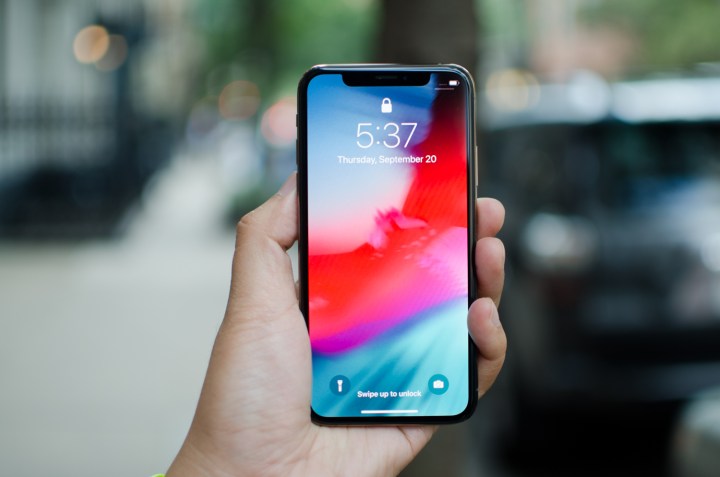
The iPhone XS is here, and it’s Apple’s best iPhone yet. It’s also the smallest iPhone of the new crop, but it’s still equipped with Apple’s powerful new processor, a stunning design, and improvements to make you sit up and take notice.
But it’s not all about Apple. LG has a solid reputation, and the LG G7 ThinQ is a fine phone with much to recommend. If you’re an LG fan, should you consider jumping ship to the new iPhone XS? Or, if you’re an iOS user, does LG’s flagship deserve your attention? We took a look to find out.
Specs
| iPhone XS |
LG G7 ThinQ | |
| Size | 143.6 x 70.9 x 7.7mm (5.65 x 2.79 x 0.30 inches) | 153.2 x 71.9 x 7.9 mm (6.03 x 2.83 x 0.31 inches) |
| Weight | 177 grams (6.24 ounces) | 162 grams (5.71 ounces) |
| Screen size | 5.8-inch Super Retina HD OLED True Tone display | 6.1-inch IPS LCD |
| Screen resolution | 2,436 x 1,125 pixels (458 pixels per inch) | 3120 x 1440 pixels (564 pixels per inch) |
| Operating system | iOS 12 | Android 8.0 Oreo |
| Storage space | ||
| MicroSD card slot | No | Yes, up to 2TB |
| Tap-to-pay services | Apple Pay | Google Pay, LG Pay (in South Korea only) |
| Processor | Apple A12 Bionic | Qualcomm Snapdragon 845 |
| RAM | ||
| Camera | Dual 12MP (with dual OIS) rear, 7MP TrueDepth front camera | Dual 16MP (with OIS) and 16MP wide-angle rear, 8MP front |
| Video | 4K at 30 frames per second. 1080p at 60fps. Optical image stabilization. | Up to 4K at 30 frames per second |
| Bluetooth version | Bluetooth 5.0 | Bluetooth 5.0 |
| Ports | Lightning | 3.5mm headphone jack, USB-C |
| Fingerprint sensor | No (FaceID instead) | Yes |
| Water resistance | IP68 | IP68 |
| Battery | 2,658mAh
Fast charge capable (additional charger needed) Qi wireless charging |
3,000mAh
QuickCharge 3.0 (4.0 with adapter not included) Qi wireless charging |
| App marketplace | Apple App Store | Google Play Store |
| Network support | T-Mobile, AT&T, Verizon, Sprint | T-Mobile, AT&T, Verizon, Sprint |
| Colors | Silver, space gray, gold | Aurora Black, Platinum Gray, Raspberry Rose, and Moroccan Blue |
| Price | $1,000 | $750 |
| Buy from | Apple | LG, Amazon, Best Buy |
| Review score | 4.5 out of 5 stars | 3.5 out of 5 stars |
Performance, battery life, and charging

Thanks to powerful specs, you’ll get great performance from both of these phones. The G7 ThinQ is powered by the Snapdragon 845, and it provided strong and stable performance throughout our review period. The same is also true of the iPhone XS’s A12 Bionic processor, which provided super-smooth performance during intensive games and swapping between apps. There’s a clear gulf in terms of pure power though, and the iPhone XS’s A12 Bionic processor absolutely demolishes the Snapdragon 845 in benchmarks. The G7 ThinQ isn’t slow, but the iPhone XS is greater in pure power, and will be able to handle more intensive tasks with ease.
The G7 comes roaring back with a longer-lasting battery though. After a day of heavy use, the G7 got home with 45 percent remaining. On a similar workday, the iPhone XS got home with just 24 percent remaining. The G7’s 3,000mAh battery could definitely be used for two days on light usage, which isn’t something we can really say of the iPhone XS’s 2,658mAh battery.
Thankfully you can plonk either of these on a wireless charging pad for little top-ups, or charge up properly with fast charging. However, the iPhone XS doesn’t come with a fast charger in the box — you’ll need to fork out extra money for that. The G7 comes with a QuickCharge 3.0 charger in the box. However, dealing with a smaller battery life is something iPhone users are used to, so it probably won’t put anyone off.
The G7 has a longer-lasting battery and a fast charger, but it’s hard to argue with the iPhone XS’s pure processing power.
Winner: iPhone XS
Design and durability
- 1. Apple iPhone XS
- 2. LG G7 ThinQ
Both phones have notched displays and modern designs, but most of the similarities end there. The iPhone XS is more or less a carbon copy of the iPhone X, so fans of that design will likely love the XS. The XS has a new gold color, but it’s otherwise that same gorgeous, bezel-free design. The LG G7 ThinQ has a similar design, but with a bit more bezel and less of the visual flair you’ll get from the iPhone. Sadly, the G7 has less of a “wow” factor when compared with the XS — even if it is packing a headphone jack.
Both phones come with IP68-rated water-resistance to withstand complete immersion in water (or beer, in the iPhone’s case) for up to 30 minutes. They’re both glass though, so you might want to be careful with your grip — glass shatters, and it can be expensive to replace. Grabbing a case is usually a good idea.
Both of these phones are good lookers with similar durability — but we reckon the iPhone XS is going to be the more attractive phone for most people.
Winner: iPhone XS
Display

The G7 ThinQ packs a 6.1-inch IPS LCD running a 3,120 x 1,440 resolution, with a super-sharp 564 pixels per inch. It’s a great display with HDR10 support and some wonderful color depth. The iPhone XS’s display isn’t as sharp, measuring 458 pixels per inch — but it makes up for it with a truly gorgeous Super Retina custom OLED display with a stunning depth of color and deep, inky blacks. The blacks are so dark that you won’t notice the notch at the top if you have a sufficiently dark wallpaper. It’s easily one of the best screens Apple has ever used.
The G7’s IPS LCD is a fine piece of screen tech — that can even get super bright to help in sunny conditions — but it’s not on the level of the XS’ screen.
Winner: iPhone XS
Camera

The LG G7 ThinQ has two 16-megapixel lenses on the back, one of which is a super-wide angle 107-degree lens. It’s a great little setup that excels at wide shots of landscapes — but it really struggles with lower-lit areas, despite the f/1.6 aperture on the main lens, and the Super Bright Camera mode. That’s not an issue with the iPhone XS, which uses two 12-megapixel lens to produce some stunning shots in a variety of situations.
LG’s camera also comes with AI Cam, which recognizes scenes, and adjusts settings with artificial intelligence. It’s not the best implementation of an A.I.-powered camera we’ve seen, and it’s nowhere near as good at post-processing as is Apple’s Smart HDR, which combines several photos to produce a more balanced photo. There’s the ability to take 4K video on both phones, too, and similar levels of selfie cameras on each.
While the G7 has a good set of shooters, it can’t match the iPhone XS.
Winner: iPhone XS
Software and updates

You’ll find Android 8.0 Oreo on the LG G7 ThinQ, with LG’s custom skin laid over the top. It’s not laden with bloatware like some other Android skins, and it comes with some nice customization options that many will enjoy. It’s not stock Android, but it’s a good software experience anyway.
The iPhone XS comes with iOS 12, and it’s a great operating system. Apple focused hard on performance for this update, and it shows. Day-to-day performance is buttery smooth, and Apple has made modifications that further improved its responsiveness. Your choice between operating systems will be very personal, and will likely come down to whichever you’re more familiar with.
There’s a clearer winner when you look at update speed. Since Apple controls iPhone hardware and the software, it’s very easy to push out new updates for iOS as and when they become available. Since LG needs to take the time to add its own spin onto Android, it can take longer for LG phones to update. While LG’s phones are nowhere near the slowest to update, the iPhone XS will be updated far quicker than the G7 — and probably for longer, too. That wins the iPhone this round.
Winner: iPhone XS
Special features

Apple tends not to introduce new features until it has polished them to a mirror-finish, so the iPhone XS doesn’t come with the quantity of special features you’ll find in many Android flagships. However, it’s still got some fun stuff up its sleeve. There’s the impressive Face ID unlocking system — which now allows for two faces in iOS 12, along with the Animoji and Memoji AR emojis, Siri Shortcuts, and other tools to dig into in iOS 12.
The G7 may have a small advantage here though. As well as Facial Recognition, you’ll find LG’s sound-boosting and impressive Boombox speaker that turns the phone into its own resonance chamber. There’s also close integration with the Google Assistant, with a dedicated button for the A.I., as well as access to Google Lens from the camera.
We think the G7’s special features are just a bit more useful.
Winner: LG G7 ThinQ
Price
The iPhone XS starts at $1,000 for 64GB of storage, with prices rising all the way to $1,350 for 512GB. As Apple’s major flagship it will work on every major U.S. carrier. The LG G7 ThinQ costs $750, but expect to pay more for more storage — though there is a slot for a MicroSD card. Like the iPhone, the G7 works on all major U.S. carriers.
Overall winner: iPhone XS
It’s almost a clean sweep for Apple’s latest iPhone, and it’s easy to see why. The iPhone XS’s power and performance is off the charts, and the improvements made to the camera and design make it a stunning improvement over last year’s iPhone X.
But it’s no shame for the G7 to lose the way it did, and it’s not hugely behind in most of the categories. If you’re more of an Android fan, and you don’t mind the slightly boring design of the G7, or you love the wide-angle camera and headphone jack, then you’ll be more than happy with LG’s flagship.
Editors' Recommendations
- We now know when Apple is adding RCS to the iPhone
- Apple is updating one of the oldest apps on your iPhone
- The best stock-trading apps for iPhone and Android in 2023
- Can my iPhone get iOS 17? Here’s every supported model
- Have an iPhone, iPad, or Apple Watch? You need to update it right now




